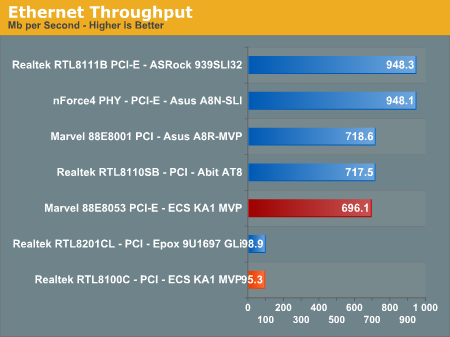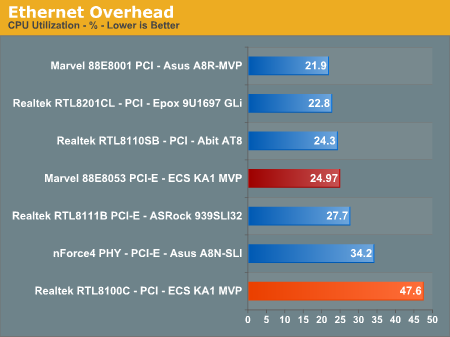Firewire and USB Performance
After looking at many options for Firewire and USB testing, we finally determined that an external USB 2.0, Firewire 400, and Firewire 800 hard disk would be a sensible way to look at USB and Firewire throughput. We utilize a RAM disk as our "server", since memory removes almost all overhead from the serving end. We turn off disk caching on the USB and Firewire side by setting up the drives for "quick disconnect" so our results are consistent.
We use 1GB of fast 3-2-2-8 system memory set up as a 450MB RAM disk and 550MB of system memory. Our standard file is the SPECviewPerf install file, which measures 432,533,504 bytes (412.4961MB). After copying this file to our RAM disk, we measured the time for writing from the RAM disk to our external USB 2.0, Firewire 400, or Firewire 800 drive utilizing our internal Windows based timing program. The copy times in seconds were then converted into Megabits per second (Mb) to provide a convenient means of comparing throughput. Higher Rates therefore mean better performance in this particular test.

Possibly the most interesting finding in our Firewire and USB throughput tests is the continued performance of an external hard drive connected to Firewire 800. Our benchmarks show Firewire 800 is up to 46% faster than a drive connected to the more common Firewire 400, and about 29% faster than the fastest USB 2.0 solution.
The ECS board offers the excellent VIA based IEEE 1394 Firewire option that typically provides better performance than the TI chipset solutions except on this board. Although the performance is acceptable, it is about 7% lower than other boards that utilize this chipset.
The USB 2.0 performance is not competitive with the ULi and NVIDIA based controllers in throughput. Even though the USB 2.0 performance numbers of the ATI SB450 are up to 50% lower, we found in actual usage the performance is fine for most peripherals. Our only issue was streaming data from our storage drive to a USB 2.0 optical drive for backup purposes. The process of creating a DVD backup consisting of 2.31GB of data took an additional 2.3 minutes compared to the same process on our Asus A8N-SLI Premium.
Ethernet Performance
The current motherboard test suite includes LAN performance measurements. All of these boards utilize PCI or PCI Express based controllers with the only difference being the supplier of the core logic.
The Windows 2000 Driver Development Kit (DDK) includes a useful LAN testing utility called NTttcp. We used the NTttcp tool to test Ethernet throughput and the CPU utilization of the various Ethernet Controllers used on the Intel motherboards.
We set up one machine as the server; in this test, an Intel system with an Intel CSA Gigabit LAN connection. Intel CSA has a reputation for providing fast throughput and is a logical choice for our Gigabit LAN server.
On the server side, we used the following Command Line as suggested by the VIA whitepaper on LAN testing:


The SB450 natively supports 10/100Mb/s Ethernet operations so the choice of the PCI-E based Marvell 88E8053 10/100/1000Mb/s Ethernet controller is an excellent upgrade to this board. The addition of the Realtek RTL8100C PCI based 10/100Mb's LAN controller should have been dropped from the option list or at least replaced with a PCI based Gigabit LAN controller, though few people will likely use both LAN ports.
The performance of the Marvell 88E8053 Gigabit LAN controller is sub-par on the ECS board. We typically see a throughput range around 940 with this controller on other boards. The 1.0e BIOS provided us with a throughput score of 631 so the 1.1d BIOS has improved the performance slightly, but it still remains network challenged at this time. We have discussed this with ECS engineering and are awaiting a potential fix at this time.
All standard Ethernet tests were performed with standard frames and the NVIDIA Active Armor suite disabled unless otherwise noted. Gigabit Ethernet supports Jumbo frames as well and provides a further reduction in CPU overhead.
After looking at many options for Firewire and USB testing, we finally determined that an external USB 2.0, Firewire 400, and Firewire 800 hard disk would be a sensible way to look at USB and Firewire throughput. We utilize a RAM disk as our "server", since memory removes almost all overhead from the serving end. We turn off disk caching on the USB and Firewire side by setting up the drives for "quick disconnect" so our results are consistent.
We use 1GB of fast 3-2-2-8 system memory set up as a 450MB RAM disk and 550MB of system memory. Our standard file is the SPECviewPerf install file, which measures 432,533,504 bytes (412.4961MB). After copying this file to our RAM disk, we measured the time for writing from the RAM disk to our external USB 2.0, Firewire 400, or Firewire 800 drive utilizing our internal Windows based timing program. The copy times in seconds were then converted into Megabits per second (Mb) to provide a convenient means of comparing throughput. Higher Rates therefore mean better performance in this particular test.

Possibly the most interesting finding in our Firewire and USB throughput tests is the continued performance of an external hard drive connected to Firewire 800. Our benchmarks show Firewire 800 is up to 46% faster than a drive connected to the more common Firewire 400, and about 29% faster than the fastest USB 2.0 solution.
The ECS board offers the excellent VIA based IEEE 1394 Firewire option that typically provides better performance than the TI chipset solutions except on this board. Although the performance is acceptable, it is about 7% lower than other boards that utilize this chipset.
The USB 2.0 performance is not competitive with the ULi and NVIDIA based controllers in throughput. Even though the USB 2.0 performance numbers of the ATI SB450 are up to 50% lower, we found in actual usage the performance is fine for most peripherals. Our only issue was streaming data from our storage drive to a USB 2.0 optical drive for backup purposes. The process of creating a DVD backup consisting of 2.31GB of data took an additional 2.3 minutes compared to the same process on our Asus A8N-SLI Premium.
Ethernet Performance
The current motherboard test suite includes LAN performance measurements. All of these boards utilize PCI or PCI Express based controllers with the only difference being the supplier of the core logic.
The Windows 2000 Driver Development Kit (DDK) includes a useful LAN testing utility called NTttcp. We used the NTttcp tool to test Ethernet throughput and the CPU utilization of the various Ethernet Controllers used on the Intel motherboards.
We set up one machine as the server; in this test, an Intel system with an Intel CSA Gigabit LAN connection. Intel CSA has a reputation for providing fast throughput and is a logical choice for our Gigabit LAN server.
On the server side, we used the following Command Line as suggested by the VIA whitepaper on LAN testing:
Ntttcpr -m 4,0,‹server IP› -a 4 -l 256000 -n 30000
On the client side (the motherboard under test), we used the following Command Line:Ntttcps -m 4,0,‹client IP› -a 4 -l 256000 -n 30000
At the conclusion of the test, we captured the throughput and CPU utilization figures from the client screen.

The SB450 natively supports 10/100Mb/s Ethernet operations so the choice of the PCI-E based Marvell 88E8053 10/100/1000Mb/s Ethernet controller is an excellent upgrade to this board. The addition of the Realtek RTL8100C PCI based 10/100Mb's LAN controller should have been dropped from the option list or at least replaced with a PCI based Gigabit LAN controller, though few people will likely use both LAN ports.
The performance of the Marvell 88E8053 Gigabit LAN controller is sub-par on the ECS board. We typically see a throughput range around 940 with this controller on other boards. The 1.0e BIOS provided us with a throughput score of 631 so the 1.1d BIOS has improved the performance slightly, but it still remains network challenged at this time. We have discussed this with ECS engineering and are awaiting a potential fix at this time.
All standard Ethernet tests were performed with standard frames and the NVIDIA Active Armor suite disabled unless otherwise noted. Gigabit Ethernet supports Jumbo frames as well and provides a further reduction in CPU overhead.










23 Comments
View All Comments
Per Hansson - Saturday, April 8, 2006 - link
Well, from your last mobo review: "Attention - Per Hansson by Gary Key on: Mar 23, 2006 12:06 AMRating: 4Our next article will have a high resolution picture of the capacitors and other items of importance in a pop-up window. I am sure the capacitors utilized on this board will be of interest to you. ;->"
Gary Key - Saturday, April 8, 2006 - link
Please email me - I have the photographs. We are doing some revisions on the engine and could not get these in but I did take the photographs for you.
Stas - Wednesday, April 5, 2006 - link
I always had nVidia and ViA chjpset based mobos. Now I really want an ATi based mobo. Very nice perfromance and overclockablility. It's good that ECS made a board like that, better for the competition. I got tired of seeing 1337 ASUS and DFI mobos, now it's time for less popular companies.SilverTrine - Tuesday, April 4, 2006 - link
And somehow Nvidia gets a pass for all their issues. The original Nforce was a totally unstable board on par with something like Abits awful KG7. Yet the fanboism let many to the slaughter with that board. Nforce 2 also had severe USB and IDE problems, yet fanboism kept most of that in the dark.Hopefully we can all get past the fanboism and be honest about things, as long as people are getting paid to post on boards that is a pipe dream though. We simply have to call these vultures on their conduct.
QueBert - Tuesday, April 4, 2006 - link
I owned a number of Nf2 MB's, and now a Nf3. SW-IDE doesn't work at all on any of them for me. Infact on 1, it actually caused my burner to not burn until I uninstalled them. Nf3 I have the lovely NF Firewall thing, does this work even somewhat for anyone? I'm not a fan boy, but from my past Nvidia experince (and remember I run a NF3 board now...) the ATI couldn't possibly be much worse. could this board be bad? sure, you can take a decent chipset and ruin it with a poorly designed motherboard.bob661 - Tuesday, April 4, 2006 - link
I'm going to test the firewall sometime when I get the chance. I'm willing to bet I won't have problems but I could be wrong.Regs - Tuesday, April 4, 2006 - link
Examples of the peripherals that are suffering? Any one else want to fill me in?
Gary Key - Tuesday, April 4, 2006 - link
The Firewire and Marvel Gigabit Ethernet controller are tied to the SB450. The performance of these items are sub-par compared to results on other boards. This is explained in the test detail sections and the final words recap. We have a new bios today that should bring the performance of both peripherals up to par with other boards that utilize this same components. However, there is nothing that can be done with the USB 2.0 performance although it really is not that bad. :)JakeBlade - Tuesday, April 4, 2006 - link
I find it amazing that this website can test a motherboard more thoroughly than the company who makes it. Pathetic.highlnder69 - Tuesday, April 4, 2006 - link
You might want to fix the word mothergoard in the title to be motherboard..